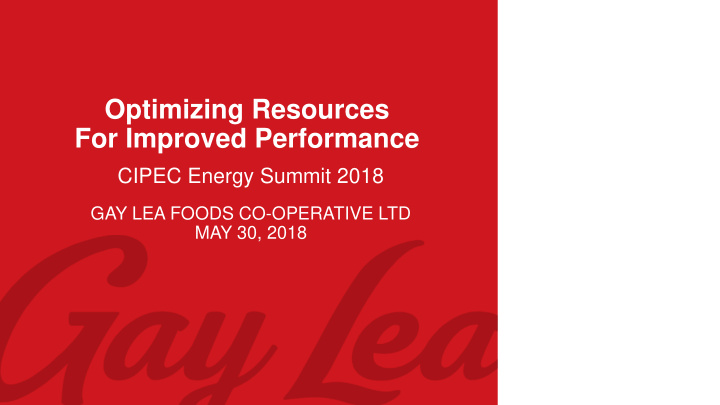



Optimizing Resources For Improved Performance CIPEC Energy Summit 2018 GAY LEA FOODS CO-OPERATIVE LTD MAY 30, 2018
ZBIGNIEW EWERTOWSKI , P.ENG. DIRECTOR, OPERATIONS TECHNOLOGY GAY LEA FOODS CO-OPERATIVE LTD. 5200 Orbitor Drive Mississauga, Ontario 2
GAY LEA FOODS briefly: • 11 manufacturing facilities: 9 in Ontario, 1 in Manitoba, 1 in Alberta • 662,000,000 litres of milk processed in F2017 (bovine and goat combined) • Employees: 1,012 • Sales in F2017: 788 M 3
Gay Lea range of products: Fluid milk, Cream, Whipped Cream, Various Cheeses, Cottage Cheese, Sour Cream, Butter, Milk Powder, Yoghurt 4
SPECIFIC NATURE OF DAIRY INDUSTRY 1. Biologically active substrates – dynamic in nature 2. Perishable foods 3. Shear sensitive 4. Heat treatment to destroy pathogenic microorganisms and extend shelf life: - Pasteurization and sterilization - Refrigeration and freezing - Concentration and Drying 5. Sanitary aspects 6. CFIA compliance 5
SAVING ENERGY AND WATER SAVING ENERGY AND WATER MAKES SENSE FROM A BUSINESS & ENVIRONMENTAL PERSPECTIVE 6
ENVIRONMENT Environmental issues specifically associated with dairy processing facilities include the following: • Wastewater • Solid waste • Emissions to air • Energy consumption 7
BENCHMARKING PROCESS • By benchmarking energy and water intensity against a known reference dairy process we can evaluate the energy and water efficiency of our processes • The reference dairy process is based on existing and proven practices and technologies identified from available sources. • Benchmarking can be used as an energy management strategy 8
BENCHMARKING cont’d • The benchmark score values can be used to indicate relative performance of our dairy process compared to the most efficient process identified e.g. European BAT (Best Available Technology). • The outcomes from comparisons may become a basis to evaluate potential for savings and to consider future improvements 9
KPI We develop KPIs for what we can control at the plant operations level. Key metrics include reducing kWh of electricity, m³ of natural gas and water, and kg of BOD concentrations 10
EXAMPLES FROM THE BENCHMARKING PROCESS 11
PLANT "A" Electricity Usage (2016) 0.250 0.222 0.200 0.180 0.171 0.168 0.167 0.163 0.161 kWh adj./Litre Milk 0.150 0.148 0.150 0.138 0.137 0.136 Electricity (kWh adj./L) Average 0.100 0.050 0.000 Month 12
Plant "A" Natural Gas Usage (2016) 0.030 0.027 0.025 0.025 0.023 0.022 0.021 0.021 0.021 0.020 Cubic Meter/Litre Milk 0.020 0.018 0.018 0.017 0.015 0.015 Gas (m3/L) Average 0.010 0.005 0.000 Month 13
Plant "A" Water In Usage (2016) 6.000 5.187 5.000 4.026 3.995 3.899 4.000 Litre Water/Litre Milk 3.732 3.696 3.694 3.650 3.502 3.422 3.388 3.310 3.000 Water In (L/L) Average 2.000 1.000 0.000 Month 14
Plant "A" Wastewater Generation (2016) 6.000 4.827 5.000 4.000 Litre Water/Litre Milk 3.162 3.082 2.890 2.877 2.823 2.804 2.810 3.000 2.785 2.750 Water Out (L/L) Average 2.555 2.520 2.000 1.000 0.000 Month 15
GAY LEA FOODS’ RESOURCES SAVING INITIATIVES 16
WATER • Reduction of demand for water in processing • Reduction of demand for water in cleaning • Reduction of demand for water in utilities • Water recycling and reuse • Wastewater treatment processes 17
ENERGY: ELECTRICITY AND HEAT • Conducted Audits to identify opportunities • Implementation of the findings in the compressed air and steam • Heat recovery 18
YIELD OPTIMIZATION AND PRODUCT RECOVERY • Sources of product loss • The cost of product loss • Efficient processing and process control • Minimizing waste • Maximizing product recovery 19
GOAL Reduce first, Recover-Reuse last 20
Q&A 21
Recommend
More recommend